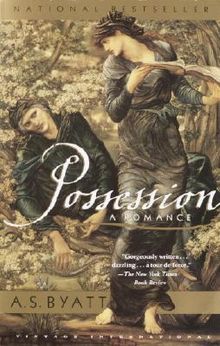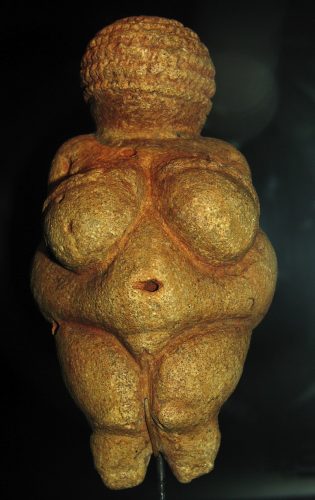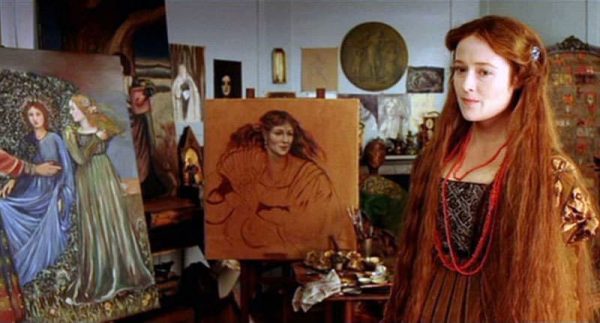Literary Reconsideration: A.S.Byatt’s “Possession”
By Vincent Czyz
Tour de force? Not quite. Joycean? Perhaps in the way contemporary individuals overlap with ancient, mythical counterparts.

A blurb from the New York Times Book Review, well known as a forum where authors enthusiastically congratulate one another, gets the front cover of the Vintage International edition of A.S. Byatt’s Possession: “Gorgeously written … dazzling …” and the most overused phrase in all of criticism: “A tour de force.” (Critics shouldn’t be allowed to use the latter until they demonstrate they know what one is.) On the back cover, the novel is compared by the Los Angeles Times Book Review to Stendhal and Joyce. I have to wonder if the reviewer has actually read Joyce — a name trotted out almost as often and mistakenly as “tour de force.” While Possession is impressive in many respects, it can be equally ham-handed in others. It has a number of flaws, none of them fatal, but cumulatively, they undercut some of the claims reviewers have made for it.
Byatt, who has amassed a notable oeuvre, including 11 novels and five short story collections, was named one of the 50 most important English writers since 1945 by the Times (London). It’s been some three decades, but since Possession may well be her crowning achievement — it took home the Booker Prize in 1990 — and since it’s a layered novel with quite a few moving parts, it bears reconsidering.
Roland Michell, a self-effacing research assistant, discovers evidence — an unsent letter moldering between the pages of an old book — of an extramarital affair between Randolph Ash, a Victorian poet whose reputation is much faded, and Christabel LaMotte, a sexually ambiguous contemporary whose poetry never brought her much critical approbation even in her own day. Michell teams up with Maud Bailey, a self-possessed literary scholar who’s been rehabilitating LaMotte’s literary standing. There are, of course, others in the field who’d love to get their hands on the unsent letter and unravel its implications, including Roland’s boss, who has “been editing Ash’s Complete Works since 1951.”
The villain is Mortimer Cropper, whose first name means “dead sea” (from Norman French), but the suggestion of death is the operative half. “Crop” as a verb means to cut; in short, he’s the Grim Reaper. In the first scene in which Cropper appears, Byatt shrouds him in black: he’s wearing a “black silk dressing gown,” over “black silk pyjamas,” “mole-black slippers,” and fiddling with a “black box.” Morty drinks black coffee (what else?), and “His car was a long black Mercedes … a swift funereal car,” in which he rides around “encased in smooth black solitude.” So there’s Cropper, a.k.a. Death, driving a hearse. At least it seems that way until Byatt insinuates we are dealing with the Devil Himself: the license plate on his car is ANK 666.
Byatt also describes him as having “American hips, ready for … the faraway ghost of a gun belt.” An obvious pot shot at American gun laws. The gun belt returns later: “Cropper elegantly raised his elegant hands; his crocodile-skin belt shifted a little like a gun belt on his lean hips.” All that’s missing is a black hat.
Backed by tons of American money, Cropper is busy buying up Randolph Ash “relics” with the clear implication that Ash’s possessions are more important than his poetry. This is Byatt’s way of saying Americans are not very bright, not even the ones with PhDs; they are so dazzled by gold-foil wrapping they forget to analyze the contents of the box. It’s a perpetuation of an old stereotype, one that Kazuo Ishiguro elegantly annihilated in The Remains of the Day. Roland, by contrast, says at least twice he’s not interested in Ash’s personal belongings, just in what he wrote. This way we can tell the Englishman is the good guy. And, yes, he’s associated with the color white.
Professor Leonora Stern is another American scholar whose bigness is repeatedly emphasized to remind us of oversized, powerful but blundering America. Complaining that her French is “primitive” (don’t think that adjective isn’t meant for Americans), she sighs, “Oh what it is to have an English education.” In spite of Leonora’s PhD in English, Byatt actually has her say, “We speak good American” — a blow below the gun belt.
Unfortunately, Byatt doesn’t quite get her American accents right. Cropper writes with jolly good English diction and Leonora sometimes sounds like a Brit as well: “I damaged it,” said Leonora, “Owing to your bad manners and lack of signals.” This is a distinctly British use of “owing” and the formal “lack of signals” is neither the way Americans speak nor the way Leonora speaks throughout most of the book.
This is satire, of course, but it’s unevenly distributed. Some characters are lampooned, others are not. Some of the scenes are plainly satire (particularly the climax on a dark and stormy night), but many are not. Everything modern is fair game; whatever is Victorian is not. It feels like Byatt couldn’t make up her mind.
Cropper’s overseas rival is James Blackadder, Roland’s boss. Blackadder doesn’t come off all that favorably — he’s “discouraged and he liked to discourage others” — but he’s the underfunded English underdog going against the rich American boor. And while both men have subsumed their identities under Ash’s — devoting their lives to someone else’s work rather than producing original work of their own — Cropper is clearly the more reprehensible. “Maud,” for example, “decided she intuited something terrible about Cropper’s imagination…. He had a peculiarly vicious version of reverse hagiography: the desire to cut his subject down to size.” Precisely what crop means, of course.
Byatt does an admirable — often brilliant — job of recreating Victorian letters and composing her own Victorian poems, but the narrative suffers from her overindulgence. Every time it seems the story is going somewhere, she throws a 10-page poem at us or 20 pages of letters or a dozen pages of diary. They bog the story down interminably. (Failing to get on with the story might be a bit Joycean.)

The 20,000-year-old Venus of Willendorf statuette. Photo: Wiki Commons.
Another difficulty with the novel is the way modern characters reiterate the situation of the characters they’re researching. Maud corresponds to LaMotte, who had a brief but intense affair with Ash, while Roland is Ash himself (he even starts writing poetry at the end of the book). Maud is also a distant relative of LaMotte’s, a convenience that will have important legal implications. Roland’s girlfriend Val stands in for Ash’s wife Ellen, while Leonora, a lesbian, doubles as LaMotte’s girlfriend, Blanche. Even Cropper is the great-great-something of an American fan of Ash’s. I think Byatt might have been a little less obsessive about the symmetry, which often smacks of contrivance.
Maud, unlike the infuriatingly passive Roland, is a worthy protagonist. But Byatt drowns her in green as she buried Cropper in black: “She was dressed with unusual coherence for an academic, Roland thought, rejecting several other ways of describing her green and white length, a long pine-green tunic over a pine-green skirt … and long shining green shoes. … She drove an immaculately glossy green Beetle.” On top of this there are green scarves and green headdresses, and in her flat Roland discovers green pillows, green sheets, and a green blanket. Byatt’s not quite done yet though: “The bathroom was a chill green grassy place, glittering with cleanness, huge dark green stoppered jars on water-green thick glass shelves, a floor tiled in glass tiles.” Oh, and “green-trellised towels.”
The reader is similarly pummeled with shades of emerald when La Motte is described: “the pale sap-green of vegetable life,” “green shadows in green tresses of young hay,” “her eyes were green, glass-green, malachite green, the cloudy green of seawater.” This strengthens the parallel between the two women, but Maud is the Queen of Green, the green of spring: she’s Ceres/Demeter the Earth Mother; she is life whereas Cropper is death.
And this recognition leads to the most interesting and original aspect of the novel. There’s an incident in which Roland peeps through a keyhole to see whether Maud is in the bathroom, recreating the most famous scene from La Motte’s best-known poem, “The Fairy Melusina.” He sees Maud wearing a dragon kimono, which is an ingenious way of conjuring up the reptilian Melusina — a woman who is a serpent from the waist down. Maud is the new Earth Mother — not the overweight, ponderous, heavy-breasted deity whose image was dug up near Willendorf, Austria, but a long, lithe, intellectually intimidating, assertive, and altogether formidable Earth goddess.
Beatrice Nest, as it happens, is the outmoded Earth Mother (she’s not named Nest for nothing), a laughingstock in academia who has been unable to finish editing the journals of Ash’s wife, Ellen, although she’s had more than a decade to do so. She is a dead ringer for the 20,000-year-old Venus of Willendorf statuette: “indisputably solid, and nevertheless amorphous, a woman of wide and abundant flesh, sedentary swelling hips, a mass of bosom, above which spread a cheerful-shaped face.” While she is painfully slow, she is not entirely inept.
To fully understand this motif, we have to recall that the Earth Mother began as the placid, chubby, fertility goddess associated with crops and the harvest. The reptilian Earth Mother first puts in an appearance as the monstrous Tiamat in the Babylonian epic Enuma Elish. She is slain and dismembered by the god Marduk, signaling a change in the guard: for millennia the Earth Mother, as the source and germinator of life, was the principal deity — perhaps the only deity — worthy of worship. Figurines in her image have been unearthed throughout Europe, Russia, Anatolia, and Siberia. But by the Bronze Age, when agriculture was widely practiced and grain storage common, raiders attacked settlements, slew their inhabitants, and stole their stores. Walls went up around cities and war became a necessity. The Earth Mother was demoted in favor of a god of war — the heavenly hierarchy now reflected the earthly reality of a ruling patriarchy.
Tiamat, though a demoness in the Enuma Elish, is descended from the Mother of All but has been transformed by an ancient defamation campaign waged by men with a political agenda. Byatt has reappropriated the anti-mother-deity propaganda so that if you thought women were only nesting birds with broad bums for warming up their broods, you should be warned they brandish talons and flesh-tearing beaks. Also worthy of note, Maud’s hair, though beautiful and golden, is associated with Medusa’s deadly locks. Here again male slander has been subverted and turned into feminine strength.

A scene from the 2002 film version of Possession.
Oddly, none of the half dozen reviews I read so much as mentions the Earth goddess, not even a brilliant and eloquently argued six-page formal analysis by Samuel R. Delany. All the odder because of the way Byatt opens the novel: the action kicks off with Roland doing research in the London Library in 1986, but the book begins with a fragment of Ash’s The Garden of Proserpina. Proserpina, we are told, is Ceres, one of many incarnations of the Earth goddess.
In the first four pages, a golden Proserpina is menaced by darkness in three separate images, starting with Ash’s fragment: “The Serpent is at [the tree’s] root, the fruit of gold/The woman in the shadow of the boughs/the running water and the grassy space”; “Lord Leighton had painted [Proserpina], distraught and floating, a golden figure in a tunnel of darkness”; and elsewhere in Ash’s poem “Proserpina is portrayed as ‘gold-skinned in the gloom’” and “grain-golden.” (Gold/golden, the color of Maud’s hair, shows up 10 times in these pages.) Roland goes on to point out that “Ears of grain were called apples of gold, which must have been the first gold in the world while metallic gold was unknown.”
Grain sustains life. Money may not be the root of all evil, but it’s merely a fiction we all agree to believe in. And let’s not forget that Cropper is backed by sacks of cash. Moreover, his eyeglass rims are gold and his black slippers are stitched with gold thread. Indeed, they are embroidered none too skillfully with the head of Mnemosyne, mother of the muses. Because of the iffy quality, the image was “often taken” for Medusa. We’ve already seen that Medusa is the denigrated Earth Mother and that Proserpina is another incarnation of the same, which perhaps makes Cropper not just death but Pluto/Hades. After all, Pluto kidnapped Proserpina and forced her to live with him as Queen of the Underworld for seven months of the year — hence the darkness surrounding the glittery deity in the first pages of the novel.
More evidence of how integral this motif is? Take a simple word like “grassy,” which shows up numerous times in key places, starting with the Ash’s initial fragment (“the grassy space,” above). Roland’s index cards are stored in two boxes — one grassy green, the other tomato red. Recall that Maud’s bathroom is a “grassy place,” and three lines of a poem recited by Val — composed by Robert Graves, author of The White Goddess — run “As Earth stirs in her winter sleep/And puts out grass and flowers/Despite the snow.”
Delany wasn’t much taken with the “glowingly, dazzlingly, mindlessly happy ending” revealed in the novel’s postscript, and from a craft point of view, he’s right. Byatt was, at least partly, forcing a theme: “There was a meadow full of young hay, and all the summer flowers in great abundance. Blue cornflowers, scarlet poppies, gold buttercups, a veil of speedwells …” Byatt names and describes 18 plants consecutively, and ends the long paragraph the way it started: “It was abundant, it seemed as though it must go on shining forever. The grasses had an enameled gloss and were connected by diamond-threads of light.” In other words, Proserpina, the shining and golden-skinned, is free of the Underworld — the world is in bloom.

Author A.S. Byatt: in Possession she excels at imitation and artifice, but is so busy with allusions, correspondences, and academic jokes she often forgets to breathe life into her characters.
As for the “gorgeous” writing reviewers swooned over, most of it’s reserved for the Victorian recreations, and even some of that comes off as awkward and a bit pretentious. Victorian scenes aside, Possession contains pages and pages of perfectly competent but unexceptional writing: “A very small woman appeared…. She wore a large apron covered with purple and grey florets, over a skinny black jumper. She had a small hard, brown-skinned face under white hair drawn into a bun.” This is a piling up of simple adjectives: colors, small (twice), large. Nor am I sure how a sweater can be “skinny,” but perhaps that’s British English. Here’s another example: “The librarian fetched a checked duster, and wiped away the dust, a black, thick, tenacious Victorian dust, a dust composed of smoke and fog particles accumulated before the Clean Air Acts.” The black dust, “composed of smoke particles,” should probably be called soot. And fog is water vapor.
Another less-than-impressive graph: “Something new, they had said. They had a perfect day for it. A day with the blue and gold good weather of anyone’s primitive childhood expectations, when the new, brief memory tells itself that this is what is, and therefore was, and therefore will be. A good day to see a new place.” Three mentions of “new” in this handful of sentences. And why “good” (two in total) in front of weather? Would blue (sky) and gold (sun) weather really be otherwise? As for “primitive childhood,” these adjectives perform an identical function; “primitive” overdoes it. And the “new, brief memory”? An awkward phrasing that is unclear to boot. An “enthusiastic letter” is “enthusiastically” written. “Coherence and closure are deep human desires that are presently fashionable. They are always both frightening and enchantingly desirable.” Aside from a form of “desire” twice, the two sentences contradict one another: “presently fashionable” and “always … desirable” are mutually exclusive.
Certainly there are handsome sentences, passages, and paragraphs, but they’re marred by sentences like these. And as critic B.R. Myers points out, prose needs to be taken on balance, not simply identified with its best moments. When I think of gorgeous, scintillating writing, I think of William Gass or Guy Davenport (almost anything by either), Marilyn Robinson’s Housekeeping, Paul West or John Updike at his best, Jean Toomer’s Cane, J.A. Phillips’s performance in Black Tickets. Byatt falls noticeably below those bars.
Tour de force? Not quite. Joycean? Perhaps in the way contemporary individuals overlap with ancient, mythical counterparts. Overall, Byatt has done exceedingly well forging a believable pair of poets from the 19th century but failed to give us fully dimensional alter egos. She excels at imitation and artifice but is so busy with allusions, correspondences, and academic jokes she often forgets to breathe life into her characters or, worse, creates caricatures. The book’s principal defect sounds a note of irony: she lampoons her scholars for their absorption in the obscurely academic, but it’s a defect she shares—that of a writer who’s taken her cues not from life lived but from literary theory learned.
Vince Czyz is the author of The Christos Mosaic, a novel, and Adrift in a Vanishing City, a collection of short fiction. He is the recipient of the Faulkner Prize for Short Fiction and two NJ Arts Council fellowships. The 2011 Capote Fellow, his work has appeared in many publications, including New England Review, Shenandoah, AGNI, The Massachusetts Review, Georgetown Review, Quiddity, Tampa Review, Boston Review, and Louisiana Literature.
